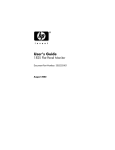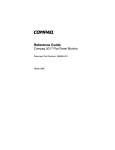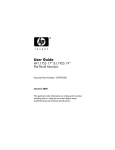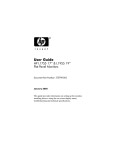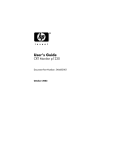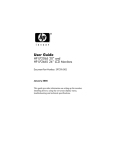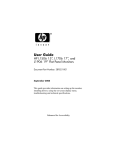Download Compaq 2025 Computer Monitor User Manual
Transcript
305494-001.book Page i Tuesday, August 20, 2002 8:36 AM b User’s Guide 2025 Flat Panel Monitor Document Part Number: 305494-001 August 2002 305494-001.book Page ii Tuesday, August 20, 2002 8:36 AM © 2002 Compaq Information Technologies, L.P. Compaq, the Compaq logo, Armada, Deskpro, Evo and iPAQ are trademarks of Compaq Information Technologies Group, L.P. in the U.S. and other countries. All other product names mentioned herein may be trademarks of their respective companies. Compaq Computer Corporation shall not be liable for technical or editorial errors or omissions contained herein or for incidental or consequential damages in connection with the furnishing, performance, or use of this material. The information in this document is provided “as is” without warranty of any kind, including, but not limited to, the implied warranties of merchantability and fitness for a particular purpose, and is subject to change without notice. The warranties for Compaq products are set forth in the express limited warranty statements accompanying such products. Nothing herein should be construed as constituting an additional warranty. This document contains proprietary information that is protected by copyright. No part of this document may be photocopied, reproduced, or translated to another language without the prior written consent of Compaq Computer Corporation. Å WARNING: Text set off in this manner indicates that failure to follow directions could result in bodily harm or loss of life. Ä CAUTION: Text set off in this manner indicates that failure to follow directions could result in damage to equipment or loss of information. User’s Guide 2025 Flat Panel Monitor First Edition August 2002 Document Part Number: 305494-001 305494-001.book Page 1 Tuesday, August 20, 2002 8:36 AM Contents 2025 Flat Panel Display Product Features. . . . . . . . . . . . . . . . . . . . . . . . . . . . . . . . 1–1 Information Files . . . . . . . . . . . . . . . . . . . . . . . . . . . . 1–2 Setting Up the Monitor. . . . . . . . . . . . . . . . . . . . . . . . . . . 1–3 Selecting the Signal Connectors and Cables . . . . . . . 1–6 Removing the Monitor Base . . . . . . . . . . . . . . . . . . . 1–7 Mounting the Monitor . . . . . . . . . . . . . . . . . . . . . . . . 1–9 Operating the Monitor . . . . . . . . . . . . . . . . . . . . . . . . . . 1–10 On-Screen Display Settings. . . . . . . . . . . . . . . . . . . 1–12 Adjusting Monitor Settings . . . . . . . . . . . . . . . . . . . 1–14 Identifying Special OSD Messages . . . . . . . . . . . . . 1–14 Adjusting Screen Quality. . . . . . . . . . . . . . . . . . . . . 1–15 Optimizing Digital Conversion . . . . . . . . . . . . . . . . 1–15 Recognizing Preset Display Resolutions. . . . . . . . . 1–16 Entering User Modes . . . . . . . . . . . . . . . . . . . . . . . . 1–17 Energy Saver Feature. . . . . . . . . . . . . . . . . . . . . . . . 1–17 Care and Maintenance . . . . . . . . . . . . . . . . . . . . . . . . . . 1–18 Protecting the Monitor. . . . . . . . . . . . . . . . . . . . . . . 1–18 Cleaning the Monitor. . . . . . . . . . . . . . . . . . . . . . . . 1–19 Shipping the Monitor. . . . . . . . . . . . . . . . . . . . . . . . 1–20 Specifications . . . . . . . . . . . . . . . . . . . . . . . . . . . . . . . . . 1–21 Agency Regulatory Notices Federal Communications Commission Notice. . . . . . . . A–23 Modifications. . . . . . . . . . . . . . . . . . . . . . . . . . . . . . A–24 Cables . . . . . . . . . . . . . . . . . . . . . . . . . . . . . . . . . . . A–24 User’s Guide 1 305494-001.book Page 2 Tuesday, August 20, 2002 8:36 AM Declaration of Conformity for Products Marked with FCC Logo, United States Only. . . . . . . . . . . . . . . . . . . . . . . . A–24 Canadian Notice . . . . . . . . . . . . . . . . . . . . . . . . . . . A–25 Avis Canadien . . . . . . . . . . . . . . . . . . . . . . . . . . . . . A–25 European Notice . . . . . . . . . . . . . . . . . . . . . . . . . . . A–25 Japanese Notice . . . . . . . . . . . . . . . . . . . . . . . . . . . . A–26 EPA Energy Star Compliance . . . . . . . . . . . . . . . . . A–26 TCO ‘99 . . . . . . . . . . . . . . . . . . . . . . . . . . . . . . . . . . . . . A–26 Congratulations! . . . . . . . . . . . . . . . . . . . . . . . . . . . A–26 Why do we have environmentally labelled computers? . . A–27 What does labelling involve? . . . . . . . . . . . . . . . . . A–27 Environmental requirements . . . . . . . . . . . . . . . . . . A–29 Power Cord Set Requirements . . . . . . . . . . . . . . . . . . . . A–31 2 User’s Guide 305494-001.book Page 1 Tuesday, August 20, 2002 8:36 AM 2025 Flat Panel Display Product Features The 2025 Flat Panel Display has an active matrix, thin-film transistor (TFT), liquid crystal display (LCD). The monitor features include: ■ ■ ■ ■ ■ ■ ■ ■ ■ ■ User’s Guide Large 20.1-inch (51 cm) viewable area display. 1600 × 1200 resolution, plus full-screen support for lower resolutions. Wide viewing angle to allow viewing from a sitting or standing position, or moving side-to-side. Tilt and swivel adjustment capabilities. Removable base for flexible mounting solutions. Multiple video inputs supported: ❏ VGA Analog ❏ DVI-I supports either Analog or Digital signal input ❏ Super Video ❏ Composite Video Video input includes PiP (Picture in Picture) option for windowed video display over data display. VGA analog and DVI-Digital signal cables included. Plug and play capability if supported by your system. On-Screen Display (OSD) adjustments in English, French, German, Italian, Spanish, and Simplified Chinese for ease of set-up and screen optimization. 1 305494-001.book Page 2 Tuesday, August 20, 2002 8:36 AM 2025 Flat Panel Display ■ Software and Reference Library CD includes an information file (INF), Image Color Matching file (ICM), and product documentation. ■ Energy Saver feature for Energy Star compliance. ■ AssetControl ■ Compliant with the following regulated specifications: ❏ EPA ENERGY STAR ❏ European Union CE Directives ❏ Swedish MPR II 1990 ❏ Swedish TCO '99 Information Files The CD-ROM included with this monitor contains two information files to be installed onto your computer; an .INF file and an .ICM file. ■ The .INF file defines monitor resources and provides specifications used by most operating systems to install support software for certain hardware devices. The .INF file ensures monitor compatibility and optimization with your computer’s graphics adapter. INF files are downloadable by clicking on: www.hp.com/go/support and selecting the desired monitor. ■ The .ICM file provides color matching consistency from monitor screen to printer and is activated from within graphics programs that have this feature. To install these files on your computer, insert the Software and Reference Library CD in your computer CD-ROM drive. When the CD menu launches, select Install INF and ICM Files and follow the on-screen instructions. 2 User’s Guide 305494-001.book Page 3 Tuesday, August 20, 2002 8:36 AM 2025 Flat Panel Display Setting Up the Monitor To set up the monitor, ensure that the power is turned off to the monitor, computer system, and other attached devices, then follow these steps: 1. Place the monitor in a convenient, well-ventilated location near your computer. 2. Connect the monitor signal cable to the video connector on the rear panel of the computer. DVI-D cable supplied with this monitor is for ✎ The digital-to-digital connection only. Your computer must have a DVI-compatible graphics card installed for use with this cable. When connecting the DVI-D signal cable to the DVI connector on the monitor, you must connect the other end of the DVI-D cable to the DVI connector on the computer. 3. Connect the monitor signal cable to the back of the monitor. 4. Connect the power cable to the back of the monitor. 5. Connect the power cable to an electrical wall outlet. User’s Guide 3 305494-001.book Page 4 Tuesday, August 20, 2002 8:36 AM 2025 Flat Panel Display 6. Adjust the monitor as needed for your comfort using the monitor’s tilt, swivel, and height adjustment capabilities. 4 User’s Guide 305494-001.book Page 5 Tuesday, August 20, 2002 8:36 AM 2025 Flat Panel Display User’s Guide 5 305494-001.book Page 6 Tuesday, August 20, 2002 8:36 AM 2025 Flat Panel Display Å WARNING: To reduce the risk of electric shock or damage to your equipment: Do not disable the power cord grounding plug. The grounding plug is an important safety feature. Plug the power cord into a grounded (earthed) electrical outlet that is easily accessible at all times. Disconnect power from the monitor by unplugging the power cord from the electrical outlet. Do not place anything on power cords or cables. Arrange them so that no one may accidentally step on or trip over them. Do not pull on a cord or cable. When unplugging from the electrical outlet, grasp the cord by the plug. Ä CAUTION: Burn-in image damage may occur on monitors that display the same static image on screen for a prolonged period of time. To avoid burn-in image damage on your monitor screen, you should always activate a screen saver application or turn off the monitor when it is not in use for a prolonged period of time. Selecting the Signal Connectors and Cables There are four signal input connectors: one VGA connector, one DVI-I connector, one super video connector, and one composite video connector. The monitor will automatically determine which inputs have valid video signals. The inputs can be selected via the On-Screen Display (OSD) feature or by pressing the Signal Input Selection control on the monitor front bezel. The video mode supported by the DVI-I connector is determined by the video cable used. For digital operation, use the DVI-D to DVI-D signal cable provided. For analog operation, a DVI-I to VGA signal cable must be attached to the DVI-I input (not provided with the monitor). 6 User’s Guide 305494-001.book Page 7 Tuesday, August 20, 2002 8:36 AM 2025 Flat Panel Display Removing the Monitor Base Before you can mount the monitor onto a swing arm or other mounting fixture, you must remove the monitor from the base. Ä CAUTION: Before beginning to disassemble the monitor, be sure the monitor is turned off and the power and signal cables are both disconnected. To remove the monitor from the base: Ä CAUTION: Lay the front bezel down on a soft area to prevent it from getting scratched, defaced, or broken. Å WARNING: Before removing the monitor from the base, ensure that the monitor is lying flat, front bezel down, and that the base is set to the maximum base extension. Attempting to remove the monitor from the base while upright in the minimum base extension may result in injury to the user. 1. Disconnect and remove the signal and power cables from the back of the monitor. User’s Guide 7 305494-001.book Page 8 Tuesday, August 20, 2002 8:36 AM 2025 Flat Panel Display 2. Remove the four screws as shown in the following illustration. Ä CAUTION: Ensure that the bottom of the monitor base is positioned over a table or desktop before removing the base from the monitor. 3. Remove the monitor base from the monitor. 8 User’s Guide 305494-001.book Page 9 Tuesday, August 20, 2002 8:36 AM 2025 Flat Panel Display Mounting the Monitor 1. Remove the monitor base. Refer to “Removing the Monitor Base” steps in the previous section. When the base is removed, four threaded mounting holes are exposed on the monitor panel to be used for mounting purposes. These mounting holes are spaced 100 mm apart and are compliant with the Video Electronics Standards Association (VESA) standard for mounting flat panel displays. 2. Mount the monitor to a swing arm or other mounting fixture by following the instructions included with the mounting fixture to be used. User’s Guide 9 305494-001.book Page 10 Tuesday, August 20, 2002 8:36 AM 2025 Flat Panel Display Operating the Monitor Front Panel Controls No. Icon 1 Pip Pip button Function Activates Picture in Picture (Pip) window Signal Input LEDs PC LED activates when VGA or DVI-I is displayed; video LED activates when super video or composite video is displayed 2 10 Control 3 INPUT Signal Input button Signal input selection - scrolls through VGA, DVI-I, super video, and composite video inputs 4 AUTO AUTO button Auto adjustment of displayed image User’s Guide 305494-001.book Page 11 Tuesday, August 20, 2002 8:36 AM 2025 Flat Panel Display Front Panel Controls No. Icon 5 1,2 Control OSD Adjusts Function Selects VGA (Input 1) or DVI-I (Input 2) when OSD is Off Selects and adjusts the OSD Menu settings 6 7 Brightness icon Indicates brightness controls, which are used to adjusts the screen brightness. 8 OSD Adjusts Selects and adjusts the OSD Menu settings, and adjusts brightness when the OSD is off. 9 Menu Opens the OSD and activates the menu - Power Switch Turns the monitor on and off q Power LED Illuminates when power is turned on User’s Guide 11 305494-001.book Page 12 Tuesday, August 20, 2002 8:36 AM 2025 Flat Panel Display On-Screen Display Settings The adjustments for screen settings are located in the on-screen display (OSD). Press the OK button on the monitor's front panel to view the OSD menu in one of six available languages. The following table shows the menus and their functions at each level: OSD Menu Levels Menu Level 1 Adjust Position Menu Level 2 Menu Level 3 Menu Level 4 Horizontal Vertical Adjust Size Full Screen Native Mode Fill with Aspect Brightness & Contrast Brightness Contrast Video Noise Phase Clock Adjust Color Original Panel Color 9300K for CAD/CAM 6500K for Image Management User Preset Red Green Blue 12 User’s Guide 305494-001.book Page 13 Tuesday, August 20, 2002 8:36 AM 2025 Flat Panel Display OSD Menu Levels Menu Level 1 OSD Setting Menu Level 2 Menu Level 3 Menu Level 4 Horizontal Vertical Product Information Serial No. Resolution Video Input Input Selection Analog (D-Sub) Analog (DVI) Digital (DVI) CVBS S-Video Picture in Picture Size On/Off Small Medium Large Position Horizontal Vertical Reset to Factory Setting Exit Main Controls User’s Guide 13 305494-001.book Page 14 Tuesday, August 20, 2002 8:36 AM 2025 Flat Panel Display Video Noise OSD selection is not available when the monitor ✎ The is operating in the DVI-D (digital ) mode. Adjusting Monitor Settings On the front controls of your monitor, once you press the OK button, the On Screen Display (OSD) Main Controls window will pop up and you can now start making adjustments to your monitor’s various features. Use the left, right, up, and down arrow keys to make your adjustments within. Identifying Special OSD Messages Special OSD messages appear on the monitor screen when identifying the following monitor conditions: ■ 14 Cannot display this video mode, change computer display input to 1600 x 1200 @ 60Hz—indicates the monitor is unable to access or fully support the provided input signal. User’s Guide 305494-001.book Page 15 Tuesday, August 20, 2002 8:36 AM 2025 Flat Panel Display ■ Entering sleep mode—Indicates the screen display is entering a sleep mode. ■ No video input—Indicates the video cable may not be plugged into the computer or the computer may not be turned on. Adjusting Screen Quality Allow the monitor to warm up for 20 minutes before performing the following procedures. The Auto Adjustment feature automatically fine-tunes the image quality each time a new video mode is utilized. If additional improvement is desired, select the Auto Adjust control on the front bezel. For more precise adjustments, use the adjustment pattern provided on the CD-ROM, and adjust the clock and phase settings (accessed via the OSD) as described in the following section. Optimizing Digital Conversion This monitor contains advanced circuitry that allows the flat panel screen to function like a standard monitor. Two controls in the on-screen display can be adjusted to improve image performance: Clock and Clock Phase. Use these controls only when the auto adjust function does not provide a satisfactory image. ■ Clock—Increase/decrease the value to minimize any vertical bars or stripes visible on the screen background. ■ Clock Phase—Increase/decrease the value to minimize video distortion or video jitter. User’s Guide 15 305494-001.book Page 16 Tuesday, August 20, 2002 8:36 AM 2025 Flat Panel Display Clock must first be set correctly since the Clock Phase ✎ The settings are dependent on the main Clock setting. When using the controls, you will obtain the best results by using the adjustment pattern provided on the CD-ROM. When adjusting the Clock and Clock Phase values, if the monitor images become distorted, continue adjusting the values until the distortion disappears. To restore the factory settings, select Yes from the Factory Reset menu in the on-screen display. Recognizing Preset Display Resolutions The display resolutions listed below are the most commonly used modes and are set as factory defaults. This monitor automatically recognizes these preset modes and they will appear properly sized and centered on the screen. Factory Preset Display Modes 16 Preset Pixel Format Horz Freq (kHz) Vert Frep (Hz) 1 720 x 400 31.5 70.0 2 640 x 480 31.4 59.9 3 640 x 480 37.50 75.0 4 640 x 480 43.37 85.01 5 800 x 600 37.8 60.32 6 800 x 600 53.67 85.6 7 832 x 624 49.7 75.0 8 1024 x 768 48.4 60.0 9 1024 x 768 60.0 75.0 10 1024 x 768 68.6 85.0 User’s Guide 305494-001.book Page 17 Tuesday, August 20, 2002 8:36 AM 2025 Flat Panel Display Factory Preset Display Modes Preset Pixel Format Horz Freq (kHz) Vert Frep (Hz) 11 1152 x 870 69.0 75.0 12 1152 x 900 61.80 65.96 13 1280 x 960 60.0 60.0 14 1280 x 1024 63.9 60.0 15 1280 x 1024 79.98 75.0 16 1280 x 1024 91.1 85.0 17 1600 x 1200 75.0 60.0 18 1600 x 1200 93.8 75.0 Entering User Modes The video controller signal may occasionally call for a mode that is not preset if: ■ You are not using a Compaq standard graphics adapter. ■ You are not using a preset mode. If this occurs, you may need to readjust the parameters of the monitor screen by using the on-screen display. Your changes can be made to any or all of these modes and saved in memory. The monitor automatically stores the new setting, then recognizes the new mode just as it does a preset mode. In addition to the 18 factory preset modes, there are four user modes that can be entered and stored. Energy Saver Feature When the monitor is in its normal operating mode, the monitor uses less than 70 watts of power and the Power light is green. The monitor also supports a reduced power state. The reduced power state will be entered into if the monitor detects the absence of either the horizontal sync signal and/or the vertical sync signal. User’s Guide 17 305494-001.book Page 18 Tuesday, August 20, 2002 8:36 AM 2025 Flat Panel Display Upon detecting the absence of these signals, the monitor screen is blanked, the backlight is turned off, and the Power light is turned amber. When the monitor is in the reduced power state, the monitor will utilize less than 5 watts of power. There is a brief warm up period before the monitor will return to its normal operating mode. Refer to your computer manual for instructions on setting energy saver features (sometimes called power management features). above energy saver feature only works when connected to ✎ The computers that have energy saver features. By selecting settings in the monitor’s Energy Saver utility, you can also program the monitor to enter into the reduced power state at a predetermined time. When the monitor’s Energy Saver utility causes the monitor to enter the reduced power state, the Power light blinks amber. Care and Maintenance Use the following guidelines to care for and maintain your monitor during normal everyday use. Protecting the Monitor To protect your monitor from overheating and other types of damage: 18 ■ Use only a power source and connection appropriate for this monitor, as indicated on the marking label/back plate and the AC adapter. ■ If an extension cord or power strip is used, make sure that the cord or strip is rated for the product and that the total ampere ratings of all products plugged into the extension cord or power strip do not exceed 80% of the extension cord or strip ampere ratings limit. User’s Guide 305494-001.book Page 19 Tuesday, August 20, 2002 8:36 AM 2025 Flat Panel Display ■ Do not overload an electrical outlet, power strip, or convenience receptacle. The overall system load must not exceed 80% of the branch circuit rating. If power strips are used, the load should not exceed 80% of the power strip input rating. ■ Install the monitor near an outlet that you can easily reach. Disconnect the product by grasping the plug firmly and pulling it from the outlet. Never disconnect it by pulling the cord. ■ Unplug the monitor from the wall outlet before cleaning. Do not use liquid cleaners or aerosol cleaners. ■ Slots and openings in the cabinet are provided for ventilation. These openings must not be blocked or covered. Never push objects of any kind into cabinet slots or other openings. ■ Do not drop the monitor or place it on an unstable surface. ■ Do not allow anything to rest on the power cord. Do not walk on the cord. ■ Keep the monitor in a well-ventilated area, away from excessive light, heat, and moisture. Keep the monitor away from high capacity transformers, electric motors, and other strong magnetic fields. ■ Do not open the monitor cabinet or attempt to service this product yourself. Adjust only those controls that are covered by the operating instructions. If the monitor is not operating properly or has been dropped or damaged, contact your authorized dealer, reseller, or service provider. Cleaning the Monitor To clean the monitor, follow these steps: 1. Turn off the monitor and the computer. User’s Guide 19 305494-001.book Page 20 Tuesday, August 20, 2002 8:36 AM 2025 Flat Panel Display 2. Dust the monitor by wiping the screen and the cabinet with a soft, clean cloth. If the screen requires additional cleaning, use a clean cloth dampened with isopropyl alcohol. Ä CAUTION: Do not use benzene, thinner, ammonia, or any volatile substance to clean the monitor screen or cabinet. These chemicals may damage the monitor. Never use water to clean an LCD screen. Shipping the Monitor Keep the original packing box in a storage area. You may need it later if you move or ship your monitor. 20 User’s Guide 305494-001.book Page 21 Tuesday, August 20, 2002 8:36 AM 2025 Flat Panel Display Specifications 2025 Flat Panel Monitor Display Type 20.1 inches TFT LCD 51 cm Viewable Image Size 20.1-inch diagonal 51 cm Tilt Swivel -5 to +35o -35 to +35o Face Treatment Anti-glare polarizer with hard coating Maximum Weight (Unpacked) 26.1 lbs. 11.87 kg (unpacked) Dimensions (includes pedestal) Height Depth Width 21.4 inches 8.1 inches 19.2 inches 544 mm 208 mm 488 mm Maximum Graphics Resolution 1600 x 1200 (60 Hz) digital input 1600 x 1200 (75 Hz) analog input Text Mode 720 x 400 Dot Pitch 0.255 x 0.255 mm Horizontal Frequency 30 to 94 kHz analog input 30 to 92 kHz digital input Vertical Refresh Rate 56 to 85 Hz User’s Guide 21 305494-001.book Page 22 Tuesday, August 20, 2002 8:36 AM 2025 Flat Panel Monitor Environmental Requirements Temperature Operating Temperature Non-operating Temperature 41 to 95o F -4 to +140o F 5 to 35o C -20 to +60o C Relative Humidity 20 to 80% Power Source 100 - 240 VAC, 50/60 Hz Power Consumption 52 watts typical Input Terminals 15-pin D-type connector with cable included. DVI-I connector with DVI-D cable included Viewable Image Size 20.1-inch diagonal 51 cm Color Display Values CIE* Chromaticity Coordinates x (+/- 0.030) y (+/- 0.030) Red 0.63 0.34 Blue 0.15 0.110 Green 0.30 0.58 White Chromaticity (6500 K) (9300 K) 0.31 0.28 0.34 0.31 Gamma: 2.2 * Commission International d’Eclairage, 1931 Standard. 305494-001.book Page 23 Tuesday, August 20, 2002 8:36 AM Agency Regulatory Notices Federal Communications Commission Notice This equipment has been tested and found to comply with the limits for a Class B digital device, pursuant to Part 15 of the FCC Rules. These limits are designed to provide reasonable protection against harmful interference in a residential installation. This equipment generates, uses, and can radiate radio frequency energy and, if not installed and used in accordance with the instructions, may cause harmful interference to radio communications. However, there is no guarantee that interference will not occur in a particular installation. If this equipment does cause harmful interference to radio or television reception, which can be determined by turning the equipment off and on, the user is encouraged to try to correct the interference by one or more of the following measures: ■ Reorient or relocate the receiving antenna. ■ Increase the separation between the equipment and the receiver. ■ Connect the equipment into an outlet on a circuit different from that to which the receiver is connected. ■ Consult the dealer or an experienced radio or television technician for help. User’s Guide 23 305494-001.book Page 24 Tuesday, August 20, 2002 8:36 AM Agency Regulatory Notices Modifications The FCC requires the user to be notified that any changes or modifications made to this device that are not expressly approved by Compaq Computer Corporation may void the user's authority to operate the equipment. Cables Connections to this device must be made with shielded cables with metallic RFI/EMI connector hoods to maintain compliance with FCC Rules and Regulations. Declaration of Conformity for Products Marked with FCC Logo, United States Only This device complies with Part 15 of the FCC Rules. Operation is subject to the following two conditions: (1) this device may not cause harmful interference, and (2) this device must accept any interference received, including interference that may cause undesired operation. For questions regarding your product, contact: Hewlett-Packard Company P. O. Box 692000, Mail Stop 530113 Houston, Texas 77269-2000 Or, call - 1-800- 652-6672 (1-800-OK COMPAQ) For questions regarding this FCC declaration, contact: Hewlett-Packard Company P. O. Box 692000, Mail Stop 510101 Houston, Texas 77269-2000 Or, call - (281) 514-3333 To identify this product, refer to the Part, Series, or Model number found on the product. 24 User’s Guide 305494-001.book Page 25 Tuesday, August 20, 2002 8:36 AM Agency Regulatory Notices Canadian Notice This Class B digital apparatus meets all requirements of the Canadian Interference-Causing Equipment Regulations. Avis Canadien Cet appareil numérique de la classe B respecte toutes les exigences du Règlement sur le matériel brouilleur du Canada. European Notice Products with the CE Marking comply with both the EMC Directive (89/336/EEC) and the Low Voltage Directive (73/23/EEC) issued by the Commission of the European Community. Compliance with these directives implies conformity to the following European Norms (in brackets are the equivalent international standards): ■ EN55022 (CISPR 22) - Electromagnetic Interference ■ EN55024 (IEC61000-4-2,3,4,5,6,8,11) - Electromagnetic Immunity ■ EN61000-3-2 (IEC61000-3-2) – Power Line Harmonics ■ EN61000-3-3 (IEC61000-3-3) – Power Line Flicker ■ EN60950 (IEC950) - Product Safety User’s Guide 25 305494-001.book Page 26 Tuesday, August 20, 2002 8:36 AM Agency Regulatory Notices Japanese Notice EPA Energy Star Compliance Monitors that are marked with the Energy Star Logo meet the requirements of the EPA Energy Star program. As an Energy Star Partner, Compaq Computer Corporation has determined that this product meets the Energy Star guidelines for energy efficiency. Specific details on using the Energy Saving features can be found in the energy saver or power management section of the computer manual. TCO ‘99 Congratulations! You have just purchased a TCO'99 approved and labelled product! Your choice has provided you with a product developed for professional use. Your purchase has also contributed to reducing the burden on the environment and also to the further development of environmentally adapted electronics products. 26 User’s Guide 305494-001.book Page 27 Tuesday, August 20, 2002 8:36 AM Agency Regulatory Notices Why do we have environmentally labelled computers? In many countries, environmental labelling has become an established method for encouraging the adaptation of goods and services to the environment. The main problem, as far as computers and other electronics equipment are concerned, is that environmentally harmful substances are used both in the products and during their manufacture. Since it is not so far possible to satisfactorily recycle the majority of electronics equipment, most of these potentially damaging substances sooner or later enter nature. There are also other characteristics of a computer, such as energy consumption levels, that are important from the viewpoints of both the work (internal) and natural (external) environments. Since all methods of electricity generation have a negative effect on the environment (e.g. acidic and climate-influencing emissions, radioactive waste), it is vital to save energy. Electronics equipment in offices is often left running continuously and thereby consumes a lot of energy. What does labelling involve? This product meets the requirements for the TCO'99 scheme which provides for international and environmental labelling of personal computers. The labelling scheme was developed as a joint effort by the TCO (The Swedish Confederation of Professional Employees), Svenska Naturskyddsforeningen (The Swedish Society for Nature Conservation) and Statens Energimyndighet (The Swedish National Energy Administration). Approval requirements cover a wide range of issues: environment, ergonomics, usability, emission of electric and magnetic fields, energy consumption and electrical and fire safety. User’s Guide 27 305494-001.book Page 28 Tuesday, August 20, 2002 8:36 AM Agency Regulatory Notices The environmental demands impose restrictions on the presence and use of heavy metals, brominated and chlorinated flame retardants, CFCs (freons) and chlorinated solvents, among other things. The product must be prepared for recycling and the manufacturer is obliged to have an environmental policy which must be adhered to in each country where the company implements its operational policy. The energy requirements include a demand that the computer and/or display, after a certain period of inactivity, shall reduce its power consumption to a lower level in one or more stages. The length of time to reactivate the computer shall be reasonable for the user. Labelled products must meet strict environmental demands, for example, in respect of the reduction of electric and magnetic fields, physical and visual ergonomics and good usability. Below you will find a brief summary of the environmental requirements met by this product. The complete environmental criteria document may be ordered from: TCO Development SE-114 94 Stockholm, Sweden Fax: +46 8 782 92 07 Email (Internet): [email protected] Current information regarding TCO'99 approved and labelled products may also be obtained via the Internet, using the address: http://www.tco-info.com/ 28 User’s Guide 305494-001.book Page 29 Tuesday, August 20, 2002 8:36 AM Agency Regulatory Notices Environmental requirements Flame retardants Flame retardants are present in printed circuit boards, cables, wires, casings and housings. Their purpose is to prevent, or at least to delay the spread of fire. Up to 30% of the plastic in a computer casing can consist of flame retardant substances. Most flame retardants contain bromine or chloride, and those flame retardants are chemically related to another group of environmental toxins, PCBs. Both the flame retardants containing bromine or chloride and the PCBs are suspected of giving rise to severe health effects, including reproductive damage in fish-eating birds and mammals, due to the bioaccumulative* processes. Flame retardants have been found in human blood and researchers fear that disturbances in foetus development may occur. The relevant TCO'99 demand requires that plastic components weighing more than 25 grams must not contain flame retardants with organically bound bromine or chlorine. Flame retardants are allowed in the printed circuit boards since no substitutes are available. Cadmium** Cadmium is present in rechargeable batteries and in the colour-generating layers of certain computer displays. Cadmium damages the nervous system and is toxic in high doses. The relevant TCO'99 requirement states that batteries, the colour-generating layers of display screens and the electrical or electronics components must not contain any cadmium. User’s Guide 29 305494-001.book Page 30 Tuesday, August 20, 2002 8:36 AM Agency Regulatory Notices Mercury** Mercury is sometimes found in batteries, relays and switches. It damages the nervous system and is toxic in high doses. The relevant TCO'99 requirement states that batteries may not contain any mercury. It also demands that mercury is not present in any of the electrical or electronics components associated with the labelled unit. There is however one exception. Mercury is, for the time being, permitted in the back light system of flat panel monitors as there today is no commercially available alternative. TCO aims on removing this exception when a mercury free alternative is available. CFCs (freons) The relevant TCO'99 requirement states that neither CFCs nor HCFCs may be used during the manufacture and assembly of the product. CFCs (freons) are sometimes used for washing printed circuit boards. CFCs break down ozone and thereby damage the ozone layer in the stratosphere, causing increased reception on earth of ultraviolet light with e.g. increased risks of skin cancer (malignant melanoma) as a consequence. Lead** Lead can be found in picture tubes, display screens, solders and capacitors. Lead damages the nervous system and in higher doses, causes lead poisoning. The relevant TCO´99 requirement permits the inclusion of lead since no replacement has yet been developed. *Bioaccumulative is defined as substances which accumulate within living organisms. **Lead, Cadmium and Mercury are heavy metals that are Bioaccumulative. 30 User’s Guide 305494-001.book Page 31 Tuesday, August 20, 2002 8:36 AM Agency Regulatory Notices Power Cord Set Requirements The monitor power supply is provided with Automatic Line Switching (ALS). This feature allows the monitor to operate on input voltages between 100-120V or 200-240V. The power cord set (flexible cord or wall plug) received with the monitor meets the requirements for use in the country where you purchased the equipment. If you need to obtain a power cord for a different country, you should purchase a power cord that is approved for use in that country. The power cord must be rated for the product and for the voltage and current marked on the product's electrical ratings label. The voltage and current rating of the cord should be greater than the voltage and current rating marked on the product. In addition, the cross-sectional area of the wire must be a minimum of 0.75 mm² or 18AWG, and the length of the cord must be between 6 feet (1.8 m) and 12 feet (3.6 m). If you have questions about the type of power cord to use, contact your Compaq authorized service provider. A power cord should be routed so that it is not likely to be walked on or pinched by items placed upon it or against it. Particular attention should be paid to the plug, electrical outlet, and the point where the cord exits from the product. User’s Guide 31 305494-001.book Page 32 Tuesday, August 20, 2002 8:36 AM





































